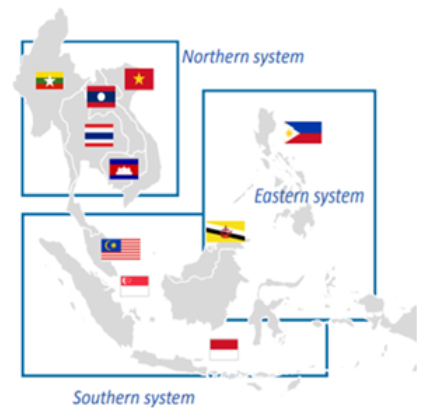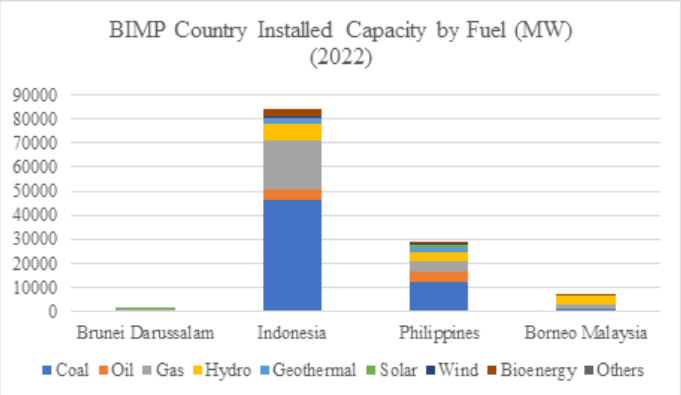Menu
One of the ASEAN regions’ focus under the ASEAN Plan of Action for Energy Cooperation (APAEC) 2016-2025 Phase II is to expand regional interconnectivity by developing multilateral power trading (MPT) within various sub-regions. Currently, ASEAN has one operating MPT project that enables the selling of electricity from Lao PDR to Singapore through the Thailand – Malaysia interconnection under the LTMS Power Interconnection Project. LTMS-PIP, as a pathfinder project, started its operation in June 2022 and has enabled 265,73 GWh of power traded from Lao PDR to Singapore by July 2023. The LTMS-PIP marked the achievement and set the tone for the region’s journey to embark on further renewable energy resource sharing and enhanced the region’s interconnectivity.
Progress of ASEAN Power Grid (APG) to date
As of now, 8 of 10 countries in ASEAN are interconnected. The region has established 10 operating bilateral interconnections with a capacity of 7,720 MW.

Photo 1. Sub-system clustering of ASEAN Power Grid in the region
The interconnections mostly exist in the North and South sub-system in ASEAN, while there is much less progress in the East sub-system (Brunei-Indonesia-Malaysia- Philippines). North sub-system has 7 operating bilateral interconnection projects, the highest quantity in both potential and existing projects. Not to mention, ASEAN’s first MPT (LTMS-PIP) is located in the North-South sub-system. On the other hand, the East sub-system only has 4 interconnection projects (with 1 operating) which is the smallest quantity compared to other sub-systems.
The recent political will to initiate of Brunei-Indonesia-Malaysia-Philippines (BIMP) project as stated in the 41st ASEAN Minister on Energy Meeting could be a turning point to accelerate the progress of regional interconnectivity in the East sub-region. Given the importance of ASEAN in realizing MPT in other sub-regions, it is worth examining deeper the lessons learned from the existing LMTS-PIP and adopt it for the initiation of BIMP-PIP considering the differences and similarities of both sub-region characteristic. The comparison is made to understand the challenges as well as opportunity helping to advance the progress of MPT in other sub-system.
This article is aim to shed a light on understanding the drivers of the varying stages of interconnection progress among the sub-region and identify what are the lesson-learn that can be adopted to initiate BIMP as the new initiative in the east sub-system.
Why ASEAN better interconnected in the north and south sub-region?
Domestic resource & electricity landscape gives a significant influence in the development of sub-region interconnectivity
The main drivers that make countries in the North and South sub-system in ASEAN to cooperate on bilateral that later leads to multilateral power trade (under LTMS-PIP) is due to the fact that there are high variation between demand and capacity to supply in between countries.
This naturally create mutual energy interdependence among the countries, especially in the north. Lao PDR, often called the battery of ASEAN, has a huge hydropower resource potential, yet small domestic demand, creates huge surplus of energy. This surplus of energy is capitalized by other country that seeks an affordable yet sustainable energy. For example, Thailand sees Lao PDR’s hydropower as opportunity due to its competitive price that is 30% and 80% cheaper than local gas generation as well as solar power enable it to have both affordable and sustainable energy.
Both Singapore and Peninsular Malaysia also have huge reliance on fossil fuel energy, shown and have limited renewable energy resource as their domestic production dominated by natural gas, shown in Figure 1. The national climate target and energy transition commitment of both countries strengthen the mutual interest to cooperate as it sees Lao PDR’s surplus in hydropower as one of the solution for them to achieve the national target.

Figure 1. Lao PDR-Thailand-Malaysia-Singapore (LTMS) Country Installed Capacity by Fuel

Figure 2. Brunei-Indonesia-Malaysia-Philippines (BIMP) Country Installed Capacity by Fuel
If we are looking into the East sub-region, is considered more or less self-sufficient using their domestic resources. Brunei Darussalam, as an oil and gas reach country rely most of the domestic generation with natural gas. While in Borneo Malaysia, Sarawak Energy aims to capitalize its surplus of renewable energy, yet its effort potentially hindered with strong domestic demand for energy.
Considering the domestic energy mix of the countries in the East sub-system, domestic self-sufficiently is put as priority that potentially dampen the bilateral interconnection progress. For example, during the initiation of the first interconnection Malaysia-Indonesia, some parts of official concern over the damage of importing energy. Sabah and Brunei are selected to have interconnection in 2024 yet since the energy mix from Sabah heavily rely on natural gas that hampers interconnection since the incentive to realize it mainly to export renewables energy. Other than that, despite Brunei Darussalam have strong similarities with Singapore in terms of land and resource scarcity, yet it prioritizes self-sufficiency through the ongoing usage of its rich natural gas with minimal emission reduction target. This creates less urgency to import renewables energy as Brunei can fulfil its energy needs through its natural gas power plant. The driver of the mutual interest and different supply capability has a lesser presence in the East compared to North & East sub-region.
A strong political will is a prominent key to drive the multi-countries cooperation
Bilateral and multilateral cooperation in the highest political level is necessary to ensure the success of interconnection and regional electricity trading projects. Cambodia – Lao PDR as well as Thailand – Lao PDR has paved years of bilateral cooperation for electricity projects and has indicated that ASEAN Power Grid and hydropower export as their main energy priority to achieve their domestic supply sufficiency. These countries has indicated the importance of the regional interconnection as priority in their national energy agenda.
Increasing bilateral cooperation will actually pave the way to establish wider regional cooperation that enables MPT. For example, Thailand specifically sees the agenda as opportunity to be regional electricity hub within the region that creates high support for LTMS Interconnection Project. Peninsular Malaysia also sees opportunity in gaining Laos electricity due to its cheaper price that can give itself energy accessibility.
Bilateral interconnections receive lack of support of prioritization in energy agenda from BIMP member states. Based on countries Power Development Plan (PDP), countries prioritize self-sufficiency within energy agenda. Indonesia and Malaysia focus on expanding its energy potential as shown in their decision to ban export of renewable energy under domestic consideration. Learning from the north sub-system, it is important to start the bilateral cooperation and explore the potential mutual benefit in the BIMP countries in establishing more interconnection in the sub-system.
Technical & infrastructure viability is the first step to be established before embarking to any MPT
LTMS-PIP infrastructure is relatively easier to realize than BIMP-PIP due to many existing bilateral interconnection that has been established and the fact that they have solved the technical requirement in interconnecting those different grid.. Before the construction of LTMS interconnection, Thailand and Lao PDR has already 6 existing interconnection that is utilize by LTMS to minimize technical hurdles. LTMS member states also has set up a technical working group to figure out the grid code requirements to enable the interconnection. The fact that all LTMS countries has the same frequency on their national grid (50 Hz) makes realization of interconnection relatively easier.
On the other hand, BIMP-PIP possibly face a harder challenge to realize due to limited existing interconnection that necessitates the building of new transmission infrastructure. On top of the necessity to enhance interconnectivity in bilateral level, the countries need to figure out the grid code and technical requirements in integrating different grid system. This poses a bit more complicated challenge to connect Philippines to the rest of the sub-system as it has different grid frequency (60 Hz, instead of 50 Hz) from the rest. Thus the only possible by the creation of HVDC transmission. Not to mention, geographical separation with Philippines causes serious challenges in technical viability that hampers the realization of full BIMP-PIP regional interconnection.
What are the key lessons from LTMS-PIP Project for spurring the development of BIMP?
One of the key drivers of LTMS interconnection is countries acknowledge the big potential of regional infrastructure in fulfilling its domestic energy need. The interdependency is the big driver to cooperate together in advancing regional interconnectivity. Currently, within BIMP countries, regional interconnection still seen as complementary tools for energy transition if the domestic supply is insufficient. Considering the recent prominent urgency and commitment for the energy transition, countries need to realize that regional connectivity is the key accelerator for them to achieve their own national goal. Regional infrastructure can offer cost-saving and investment efficiency. Hence, the policy makers, researchers, and other stakeholders need to explore perspective of how the regional potential could be tapped for the national future energy planning and utilization. Only by understanding the benefit and cost-saving potential that the regional interconnection can contribute in fulfilling the national long-term energy agenda, the regional collaboration can be spurred.
What’s next for BIMP member states to advance sub-regional interconnection?
It is obvious that natural drivers of mutual benefit and interdependency due to varying supply-demand capability that is driven LTMS succeed to be first multi-lateral power trading in the region. Thus, there are several takeaways BIMP can look forward and learn to advance the realization of MPT.
First, the mutuality spirit should be further culminated to encourage faster collaboration under BIMP. This can be done by understanding how regional interconnectivity and resource sharing could benefit BIMP countries to serve their national energy agenda. The narrative of being self-sufficient within country shall be driven towards regional self-sufficiency and security, especially amidst strong uncertainty and volatile price stage for fossil fuel commodities that has been the major resource for some BIMP countries.
Second, to further drive this change of mindset, setting domestic ‘green’ or energy transition target that aim to push higher utilization of renewable can be beneficial for driving BIMP countries to collaborate together. Currently, Indonesia is building new capital city (IKN) within Borneo Island that champion itself as green city. This is an opportunity that can be capitalized to enable renewable resource sharing from the neighbouring countries to fulfil the gap exist to supply the capital. The commitment of green city or green region could be expanded to culminate more renewable energy demand from the industry in Borneo.
Third, focus on proliferating more bilateral connection helps to lessen technical challenges in advancing sub-regional MPT. Reflecting from LTMS project, we can see that before the creation of the new MPT, each member states have already existing interconnection with one another. This therefore ease both technical and political barriers for interconnection as countries can utilize the existing grid which is relatively cheap and easy. Countries have also felt the benefit of interconnection creating organic political will to support the project. Hence current BIMP member states should focus on building bilateral interconnection and slowly advance itself with new MPT.
